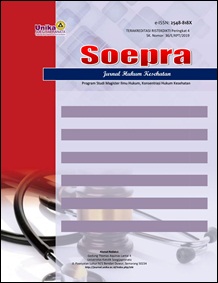Legal Aspect of Teleradiology at Hospital in Fulfillment of Patient Right
Abstract
The geographical situation and the disparity of the radiologist distribution make access to radiology services in rural, remote and island areas unmet. The presence of teleradiology can eliminate such gaps by increasing the speed and accuracy of diagnoses through technological assistance carried out in stages through the regulation of the telemedicine pilot project. Although teleradiology is currently still limited to trials, it is necessary to consider legal aspects, such as fairness, usefulness and legal certainty to the fulfillment of patient rights.
This study is sociological-juridical with explanatory research specification. This study uses primary data obtained from in-depth interview to 6 informants consisting of 1 region head IDI, one head of medical support head, 1 ICT legal expert, with one radiologist with two radiographers who is performing teleradiology. Meanwhile, secondary data as media supporting obtained through by literature and legislation review. Furthermore, data obtained are processed and analyzed qualitatively.
Based on the results of research in dr. Wahidin Sudirohusodo Makassar Hospital and H.A. Sulthan Daeng Radja Bulukumba Hospital, the implementation of teleradiology in both hospitals resulted in some of the patient's rights being unfulfilled due to infrastructure constraints, limited human resources and lack of socialization. Patients are not entitled to informed consent and the provision of medical information. The right to the second opinion is also not fulfilled so that the patient does not get a chance to seek a second chance on the diagnosis of his illness. The non-fulfillment of both rights also affects the right to patient safety in the hospital in the case of management and taking action due to incomplete medical record data. As for the legal aspects to be achieved in the implementation of teleradiology, i.e., equity, usefulness, and legal certitude aspect. However, from these three aspects, the legal certitude aspect is not implemented properly as part of the fulfillment of patient rights due to existing regulations not to set certain things that can provide legal protection for provider or recipient of teleradiology service.
Keywords
Full Text:
PDFReferences
American College of Radiology, “ACR Standard for Teleradiology”, diakses pada 28 September 2017, https://www.acr.org/Practice-Management-Quality-Informatics/Legal-Practices/Teleradiology
Antonius Maria Laot Kian, “Telemedicine dan Selfie-Medis: Anatomi Tanggungjawab Hukum Pidana Tenaga Kesehatan dalam Tindak Pidana Cyber”, disajikan dalam Seminar Nasional “Cyber Law dalam Bidang Pelayanan Kesehatan dan Implikasinya Bagi Tenaga Kesehatan” Semarang 6 Mei 2017.
Atip Latipulhayat,: “Khazanah: Jeremy Benhtham”, 2015, PADJADJARAN Jurnal Ilmu Hukum, Volume 2, Nomor 2, Tahun 2015, ISSN 2460-1543.
Dian Noeswantri,: “Pemenuhan Hak Anak Dalam Perspektif HAM”, 2004, Dinamika HAM, Volume 4, Nomor 1, Januari 2004, ISSN 1410-3982.
DTPK (Daerah Tertinggal, Perbatasan dan Kepulauan), diakses pada 20 April 2017, https://rebanas.com/kamus/kesehatan/dtpk-daerah-tertinggal-perbatasan-dan-kepulauan
Peter Mahmud Marzuki, 2006, Penelitian Hukum, Jakarta: Kencana.
Profil Kesehatan Indonesia 2015, Kementerian Kesehatan Republik Indonesia, diakses pada 23 September 2017, www.depkes.go.id/.../profil-kesehatan-indonesia/profil-kesehatan-Indonesia-2015.pdf
Pusat Komunikasi Publik Sekretariat Jenderal Kementerian Kesehatan RI, “Menkes Harapkan Kemkominfo Dukung Pemanfaatan Teknologi Informasi Dan Komunikasi (TIK) Di Bidang Kesehatan”, 31 Desember 2014, diakses pada 14 Maret 2017, http://www.depkes.go.id/article/print/15010200022/menkes-harapkan-kemkominfo-dukung-pemanfaatan-teknologi-informasi-dan-komunikasi-tik-di-bidang-keseh.html
Richard Wotton, et.al., 2009, Telehealth in the Developing World, London: Royal Society of Medicine Press Ltd.
Scott Berger and Barry Cepelewicz, 1995, “Medical-Legal Issues in Teleradiology”, American Roentgen Ray Society, diakses dari http://sci-hub.tw/10.2214/ajr.166.3.8623616.
Sudikno Mertokusumo, 2006, Penemuan Hukum, Yogyakarta: Liberty.
Suwardi Sagama,: “ Analisis Konsep Keadilan, Kepastian Hukum dan Kemanfaatan dalam Pengelolaan Lingkungan, 2016, Mazahib Jurnal Pemikiran Hukum Islam, Volume XV, Nomor 1, Tahun 2016, ISSN 1829-9067.
Wisnubro, “Sebanyak 1.250 Dokter Spesialis akan Disebar ke Pelosok Tanah Air” 24 Februari 2017, diakses pada 29 Agustus 2017, https://jpp.go.id/humaniora/kesehatan/302825-inilah-program-kemenkes-agar-tenaga-kesehatan-merata-di-tanah-air
World Health Organization,: ”Telemedicine: Opportunities and Developments in Member States: (Report On The Second Global Survey On eHealth)”, 2010, WHO Press: Global Observatory for eHealth Series, Volume 2, 2009 ISSN 2220-5462.
Perundang-undangan
RI, Undang-Undang Dasar Negara Republik Indonesia Tahun 1945
RI, Undang-Undang Nomor 39 Tahun 1999 tentang Hak Asasi Manusia
RI, Undang-Undang Nomor 29 Tahun 2004 tentang Praktik Kedokteran
RI, Undang-Undang Nomor 36 Tahun 2009 tentang Kesehatan
RI, Undang-Undang Nomor 44 Tahun 2009 tentang Rumah Sakit
RI, Undang-Undang Nomor 19 Tahun 2016 tentang Perubahan Atas Undang-Undang Nomor 11 Tahun 2008 tentang Informasi Dan Transaksi Elektronik
RI, Peraturan Pemerintah Nomor 82 Tahun 2012 tentang Penyelenggaraan Sistem dan Transaksi Elektronik
RI, Peraturan Menteri Kesehatan Nomor 269/Menkes/Per/III/2008 tentang Rekam Medis
RI, Peraturan Menteri Kesehatan Nomor 290/Menkes/Per/III/2008 tentang Persetujuan Tindakan Kedokteran
RI, Peraturan Menteri Kesehatan Nomor 780/Menkes/Per/VIII/2008 tentang Penyelenggaraan Pelayanan Radiologi
RI, Peraturan Menteri Kesehatan Nomor 1691/Menkes/Per/VIII/2011 tentang Keselamatan Pasien Rumah Sakit
RI, Peraturan Menteri Kesehatan Nomor 90 Tahun 2015 tentang Penyelenggaraan Pelayanan Kesehatan di Fasilitas Pelayanan Kesehatan Kawasan Terpencil dan Sangat Terpencil
RI, Keputusan Menteri Kesehatan Nomor 410/Menkes/SK/III/2010 tentang Perubahan Atas Keputusan Menteri Kesehatan Nomor 1014/Menkes/SK/XI/2008 tentang Standar Pelayanan Radiologi Diagnostik di Sarana Pelayanan Kesehatan
RI, Keputusan Direktur Jenderal Bina Upaya Kesehatan Kementerian Kesehatan Nomor HK.02.03/V/0209/2013 tentang Pelaksanaan Pilot Project Telemedicine dan Penunjukan Fasilitas Pelayanan Kesehatan Telemedicine Bidang Teleradiologi dan Telekardiologi
RI, Keputusan Menteri Kesehatan Nomor HK.02.02/Menkes/409/2016 tentang Rumah Sakit Uji Coba Program Pelayanan Telemedicine Berbasis Video-Conference dan Teleradiologi
RI, Keputusan Menteri Kesehatan Nomor HK.01.07/Menkes/650/2017 tentang Rumah Sakit dan Puskesmas Penyelenggara Uji Coba Program Pelayanan Telemedicine
DOI: https://doi.org/10.24167/shk.v4i2.1497
Refbacks
- There are currently no refbacks.
Copyright (c) 2018 SOEPRA







